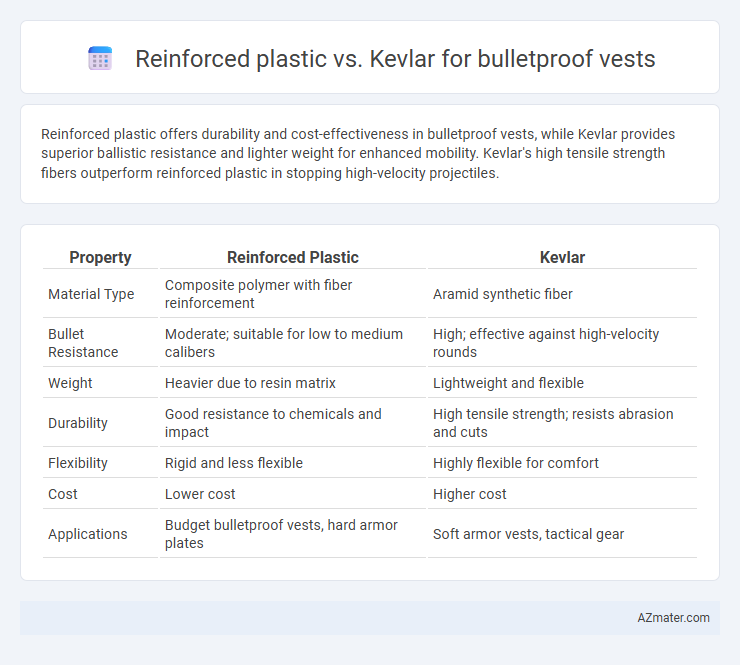Reinforced plastic offers durability and cost-effectiveness in bulletproof vests, while Kevlar provides superior ballistic resistance and lighter weight for enhanced mobility. Kevlar's high tensile strength fibers outperform reinforced plastic in stopping high-velocity projectiles.
Table of Comparison
| Property | Reinforced Plastic | Kevlar |
|---|---|---|
| Material Type | Composite polymer with fiber reinforcement | Aramid synthetic fiber |
| Bullet Resistance | Moderate; suitable for low to medium calibers | High; effective against high-velocity rounds |
| Weight | Heavier due to resin matrix | Lightweight and flexible |
| Durability | Good resistance to chemicals and impact | High tensile strength; resists abrasion and cuts |
| Flexibility | Rigid and less flexible | Highly flexible for comfort |
| Cost | Lower cost | Higher cost |
| Applications | Budget bulletproof vests, hard armor plates | Soft armor vests, tactical gear |
Introduction to Bulletproof Vest Materials
Bulletproof vests utilize advanced materials such as reinforced plastics and Kevlar to provide ballistic protection by absorbing and dispersing impact energy. Kevlar, a synthetic aramid fiber, offers high tensile strength and lightweight flexibility, making it a preferred choice for body armor. Reinforced plastics, often combined with other composite materials, enhance durability and impact resistance while maintaining a balance between weight and protection levels.
Overview of Reinforced Plastic in Ballistic Protection
Reinforced plastic in ballistic protection typically consists of composite materials that incorporate fibers such as fiberglass or carbon fiber embedded in a polymer matrix, offering a balance of lightweight properties and structural integrity. These materials provide resistance to impact and penetration by distributing the force over a larger area, making them suitable for lower-level ballistic threats. Though less effective against high-velocity rounds compared to Kevlar, reinforced plastics are valued for their durability, cost-efficiency, and versatility in various bulletproof vest applications.
Understanding Kevlar: Composition and Properties
Kevlar, a synthetic aramid fiber developed by DuPont, is renowned for its high tensile strength-to-weight ratio and exceptional impact resistance, making it a preferred material in bulletproof vests. Unlike reinforced plastics, which combine polymers with additives for rigidity, Kevlar's molecular structure consists of long chains of poly-paraphenylene terephthalamide fibers aligned parallel for maximum durability and flexibility. Its unique composition allows it to absorb and disperse kinetic energy efficiently, providing superior ballistic protection while maintaining lightweight comfort.
Comparative Ballistic Performance: Reinforced Plastic vs Kevlar
Reinforced plastic and Kevlar exhibit distinct ballistic performance characteristics in bulletproof vests, with Kevlar demonstrating superior energy absorption and multi-hit resistance due to its high tensile strength and woven fiber structure. Reinforced plastic offers lightweight advantages and rigidity but generally falls short in flexibility and prolonged impact dispersion compared to Kevlar composites. Kevlar's proven ability to dissipate ballistic forces efficiently makes it the preferred material for high-performance body armor in both military and law enforcement applications.
Weight and Comfort Considerations
Reinforced plastic bulletproof vests offer a lightweight solution, typically weighing less than Kevlar vests, which enhances mobility and reduces user fatigue during extended wear. Kevlar, however, provides superior flexibility and breathability, contributing to greater overall comfort despite its slightly heavier weight compared to reinforced plastic composites. Weight-wise, reinforced plastic materials range from 2 to 4 pounds per square meter, whereas Kevlar vests generally weigh between 3 to 5 pounds, making Kevlar less optimal for prolonged comfort but better suited for flexibility.
Flexibility and Mobility in Body Armor
Reinforced plastic offers enhanced flexibility in bulletproof vests due to its lightweight and moldable properties, allowing for greater mobility during dynamic movements. Kevlar, while offering superior ballistic resistance, is inherently stiffer, which can limit range of motion and cause fatigue over extended wear. Optimizing body armor for flexibility often involves combining reinforced plastic with Kevlar layers to balance protection and comfort effectively.
Durability and Longevity of Materials
Kevlar exhibits superior durability and longevity for bulletproof vests due to its high tensile strength and resistance to impact and wear over time. Reinforced plastic materials, while cost-effective, tend to degrade faster under repeated stress and environmental exposure, limiting their long-term protective performance. The molecular structure of Kevlar ensures consistent ballistic resistance and extended lifespan, making it the preferred choice for durable, reliable body armor.
Cost Effectiveness: Budget vs Premium Solutions
Reinforced plastic bulletproof vests offer a budget-friendly option, typically costing significantly less than Kevlar vests while providing basic ballistic protection suitable for low-risk environments. Kevlar vests, priced higher due to advanced fiber technology, deliver superior strength-to-weight ratio and enhanced multi-hit resistance, justifying the premium cost for high-threat scenarios. Comparing cost-effectiveness involves balancing initial investment against long-term durability, performance, and safety requirements specific to operational needs.
Safety Standards and Testing Procedures
Reinforced plastic and Kevlar differ significantly in meeting safety standards and testing procedures for bulletproof vests, with Kevlar often surpassing reinforced plastic due to its superior energy absorption and fragmentation resistance certified under NIJ Level IIIA. Kevlar vests undergo rigorous ballistic testing, including multiple rounds from varying calibers to ensure consistent stopping power, while reinforced plastic composites require additional layering or hybridization to match these performance benchmarks. Testing protocols emphasize trauma reduction and penetration resistance, where Kevlar consistently demonstrates compliance with international standards such as NIJ 0101.06, making it the preferred material in high-threat environments.
Choosing the Right Material for Bulletproof Vests
Kevlar offers superior tensile strength and flexibility, making it ideal for bulletproof vests requiring high impact resistance and durability. Reinforced plastics, such as fiberglass composites, provide a lightweight and cost-effective alternative but generally lack the enhanced energy absorption and multi-hit capability of Kevlar. Selecting the right material depends on balancing weight, protection level, and budget, with Kevlar favored for extensive ballistic resistance and reinforced plastics suited for lower-threat environments.

Infographic: Reinforced plastic vs Kevlar for Bulletproof vest
 azmater.com
azmater.com